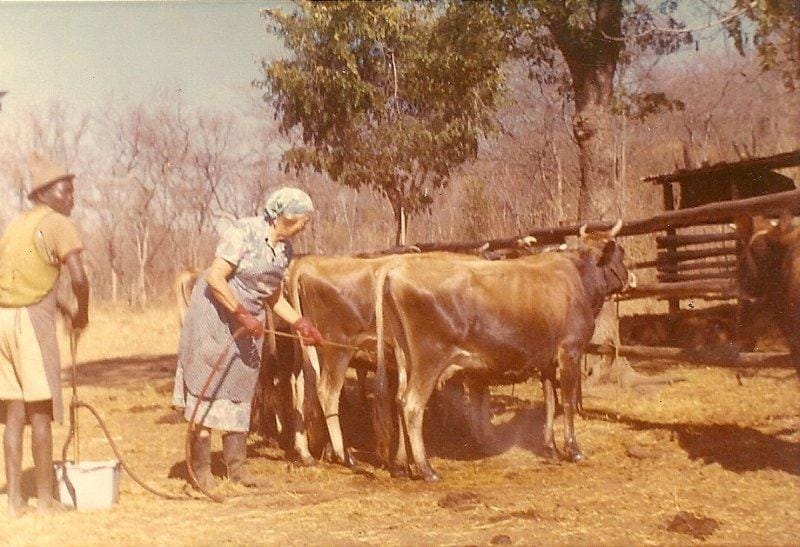Conditions of One Sort or Another

Dorothy’s Darlings getting their weekly spray down for tics 1962 – See more at: https://www.oncecalledhome.com/2013/05/conditions-of-one-sort-or-another/#sthash.bqF30mvK.dpuf
Conditions of One Sort or Another
Part of Dorothy Crowther-Smith’s conditions for marriage to Gervas Hughes were that she would bring a nucleus of her English Jersey cow herd to Melrose Farm outside Que Que. In 1948 when she was settled, Dorothy shipped a number of her best Jersey heifers from Southampton, via Capetown, and by train to Hunters Road railway station. The cows walked the last few kilometres to their new home.
Conditions of One Sort or Another
Gervas built a first class cow shed and yards for Dorothy’s ‘darling heifers.’ A local Jersey bull was purchased, siring excellent calves. She maintained a cream dairy for the rest of her life. African assistants were provided by Gervas to hand-milk the cows, but Dorothy milked her most precious pets herself every morning and evening, unless she was away for very brief and far between holidays.
At the beginning and end of the children’s school holidays, it was usually Dorothy’s job to collect or take them to the school trains at Hunters Road station. If the evening milking, was late it would result in a mad dash to the station, sometimes arriving with only a few minutes to spare. There was only one passenger train in each direction every twenty four hours so it was not a good idea to miss it.
Road conditions left a lot to be desired. The gravel road to Gwelo had two bitumen strips down the middle giving rise to the term ‘strip roads’. When vehicles met head on, each relinquished one strip a most daunting practice for new arrivals to Rhodesia like Dorothy. No speed limit applied after the usual 60 km per hour restriction in town; vehicles passed at 100 km per hour or more in opposite directions, about half a metre apart. If each driver kept to a strip there was a minimum of gravel thrown up, so windscreens were not shattered. ‘New chums,’ without the nerve, would veer to the side of the road, throwing gravel in all directions, and receive abuse in the most vile language imaginable from the experienced driver. Overtaking was achieved by creeping up behind, as close as possible without being noticed, then a sustained blast of the car horn would tell the leading driver to move off one strip. Slow trucks would normally have an African lookout sitting above the cab, whose job was to bang on the roof alerting the driver that a vehicle was about to pass.
I wonder what the roads are like these days?
Many Thanks to Tim Hughes of Queensland, Australia for the picture and the excerpts from his unpublished manuscript Matambega and Son written in the 1980’s.
